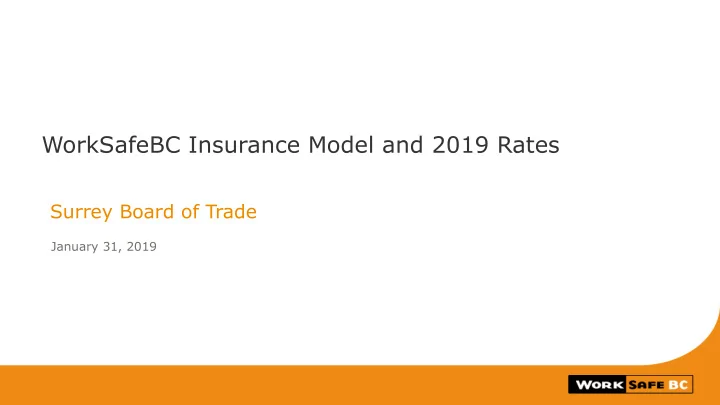

WorkSafeBC Insurance Model and 2019 Rates Surrey Board of Trade January 31, 2019
Before workers compensation Workers’ case: Employer’s defense: Duty of care Contributory negligence • • Breach of duty of care The “fellow servant” rule • • Damages The “assumption of risk” • • 90% of injured workers received no compensation
Meredith’s choices in 1915 No fault system No fault system • • Mandatory Not mandatory • • Administered by the state Administered privately • • Employers collectively liable Employers individually liable • • Accident Fund Accident Fund Accident Fund
Canadian Social Welfare Universal Health Care Income Assistance Old Age Security Employment Insurance Maternity Benefits Workers Compensation 1970 1960 1910 1920 1940 1930 1950
What your premiums pay for: 1.Income security for workers 2.Inexpensive protection from litigation 3.Standards for safe workplaces 2 4.Free expert advice 3
What is driving your rate? Premium rate drivers are: Injury prevention Injury management Number Claim costs of claims Investment returns 6
Quick facts (2017) Claims Prevention Insurance • 153,000 workplace • Occupational health and • Sole insurer of workers’ injuries reported safety regulator and compensation in British inspectorate Columbia • Income replacement benefits • 500,000+ workplaces • Employer funded • Clinical, return to work • ~ 43,000 inspections • ~ 230,000 registered (RTW), and emotional employers • ~ 34,000 safety orders support • ~ 2.4 million workers • ~ 340 penalties • Long term pensions covered • Exempt from the Canada • Premium rates set Health Act annually • Annual premiums approximately $1.5 billion 7
2017 results and 2019 rates • The provincial injury rate reached a historic low of 2.18 claims accepted per 100 person years of employment • Excellent RTW at 81.8% of workers back at work within 26 weeks • Lower Injury Rate and improved RTW outcomes led to better-than-planned claims cost performance ($197M better than plan) • Investment portfolio outperformed WorkSafeBC’s return requirements (10.5% vs 4.4%) for the year • WorkSafeBC Board of Directors has set a preliminary average base rate unchanged from 2018 of 1.55% in 2019 8
2015 – 2017 results 2015 2016 2017 Total comprehensive income $995M $488M $1,406M Investment income $1,306M $826M $1,738M Net actual market rate of return 8.7% 5.1% 10.5% Investment required rate of return 4.0% 4.5% 4.4% Total claim and operating costs $1,802M $1,857M $1,879M Injury rate 2.22 2.20 2.18 (injuries per 100 workers) Return-to-work within 26 weeks 82.6% 82.7% 81.8% Return-to-work for workers in vocational 81.0% 80.6% 82.6% rehabilitation 9
Premium rates and cost rates 2.50 2.00 1.68% 1.55% 1.50 Rate($) 1.00 0.47% 0.50 0.00 2000 2001 2002 2003 2004 2005 2006 2007 2008 2009 2010 2011 2012 2013 2014 2015 2016 2017 2018 2019 Total Cost Rate Admin Cost Rate Base Rate 10
Rate group structure 20 Above 6.00 Rate Groups 19 4.75 - 6.00 18 4.00 - 4.75 (~50) 17 3.50 -4.00 16 3.00 - 3.50 15 2.55 -3.00 ~50 14 2.15 -2.55 13 1.85 -2.15 Industry groups 12 1.55 - 1.85 (~250) ~250 11 1.35 - 1.55 10 1.15 - 1.35 9 0.95 - 1.15 8 0.80 - 0.95 ~550 Classification units 7 0.65 - 0.80 6 0.55 - 0.65 (~550) 5 0.45 - 0.55 4 0.35 - 0.45 3 0.25 -0.35 2 0.15 -0.25 1 up to 0.15 Similar classification units (CUs) are placed together into industry groups. • Industry groups with similar costs are placed into one of 20 clearly defined • and stable rate group bands with progressively higher cost rate boundaries. Sufficiently large enough industry groups form their own rate groups. • 11
2019 base premium rate changes 2% 47% 51% Base Rate Increase No change 18.0% 16.0% Percentage (%) of Employers 14.0% 12.0% 10.0% 8.0% 6.0% 4.0% 2.0% 0.0% <= -20.0% -15.0% -10.0% -5.0% No 0.1% 5.0% 10.0% 15.0% >= -20.0% to to to to Chg to to to to 20.0% -15.0% -10.0% -5.0% -0.1% 5.0% 10.0% 15.0% 20.0% % Change in Base Rate • 118,000 firms will experience base rate decreases • 108,000 firms will experience base rate increases • 4,000 firms will experience unchanged base rates 12
Experience rating: rewarding safety 100% $30,000 Surcharge 50% $15,000 Base Rate Discount -50% $7,500 For example: An employer with $1 million in payroll with a base rate of 1.50 percent would pay $15,000, but could pay as little as $7,500 or as much as $30,000, depending on its safety record over time. 13
Recommend
More recommend